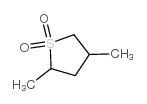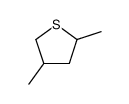1003-78-7
| 中文名 | 2,4-二甲基环丁砜 |
|---|---|
| 英文名 | 2,4-dimethylthiolane 1,1-dioxide |
| 中文别名 |
2,4-二甲基四亚甲基砜
二甲基砜茂烷 2,4-二甲基四氢噻吩-1,1-二氧化物 1,1-二氧化-2,4-二甲基四氢噻吩 |
| 英文别名 |
2,4-Dimethyltetrahydrothiophene-1,1-dioxide
MFCD00005485 2.4-Dimethyl-tetrahydrothiophen-1.1-dioxyd 2,4-Dimethyl sulfolane EINECS 213-716-5 2,4-Dimethyl-sulfolan 2,4-DIAMINOPYRIMIDINE-5-CARBOXALDEHYDE 2,4-Dimethyl-tetrahydro-thiophen-1,1-dioxid 2,4-Dimethyltetrahydrothiophene dioxide 2,4-Dimethyltetramethylene sulfone 2,4-dimethyl sulfonate |
| 密度 | 1.136 g/mL at 25 °C(lit.) |
|---|---|
| 沸点 | 281 °C(lit.) |
| 熔点 | −3 °C(lit.) |
| 分子式 | C6H12O2S |
| 分子量 | 148.22300 |
| 闪点 | 294 °F |
| 精确质量 | 148.05600 |
| PSA | 42.52000 |
| LogP | 1.91030 |
| 外观性状 | 透明淡棕色液体 |
| 蒸汽压 | 0.00688mmHg at 25°C |
| 折射率 | n20/D 1.473(lit.) |
| 储存条件 | 保持容器密封,储存在阴凉,干燥的地方 |
| 稳定性 | 常温常压下稳定,避免强氧化剂接触。 |
| 分子结构 | 1、 摩尔折射率:36.55 2、 摩尔体积(cm3/mol):135.2 3、 等张比容(90.2K):311.4 4、 表面张力(dyne/cm):28.0 5、 介电常数:不可用 6、 偶极距(10-24cm3):不可用 7、 极化率:14.48 |
| 计算化学 | 1.疏水参数计算参考值(XlogP):1 2.氢键供体数量:0 3.氢键受体数量:2 4.可旋转化学键数量:0 5.互变异构体数量:无 6.拓扑分子极性表面积42.5 7.重原子数量:9 8.表面电荷:0 9.复杂度:188 10.同位素原子数量:0 11.确定原子立构中心数量:0 12.不确定原子立构中心数量:2 13.确定化学键立构中心数量:0 14.不确定化学键立构中心数量:0 15.共价键单元数量:1 |
| 更多 | 1. 性状:无色至黄色液体。 2. 密度(g/mL,20/4℃):1.1362 3. 熔点(ºC):-3 4. 沸点(ºC,常压):281(部分分解) 5. 折射率(20ºC):1.4733 6. 闪点(ºC):143 7. 溶解性:微溶于水,与低级芳烃混溶。溶于乙醚、丙酮、甲醇。能与环烷、烯烃和石蜡部分混溶。 |
Synonym:2,4-Dimethyltetrahydrothiophene Dioxide; Thiophene, Tetrahydro-2,4-Dimethyl-, 1,1-Dioxide Section 2 - COMPOSITION, INFORMATION ON INGREDIENTS
Risk Phrases: 23/24/25 Section 3 - HAZARDS IDENTIFICATION EMERGENCY OVERVIEW
Toxic by inhalation, in contact with skin and if swallowed.The toxicological properties of this material have not been fully investigated. Potential Health Effects Eye: May cause eye irritation. Skin: May cause skin irritation. Ingestion: May cause irritation of the digestive tract. The toxicological properties of this substance have not been fully investigated. Inhalation: May cause respiratory tract irritation. The toxicological properties of this substance have not been fully investigated. Chronic: No information found. Section 4 - FIRST AID MEASURES Eyes: Flush eyes with plenty of water for at least 15 minutes, occasionally lifting the upper and lower eyelids. Get medical aid. Skin: Get medical aid. Flush skin with plenty of water for at least 15 minutes while removing contaminated clothing and shoes. Wash clothing before reuse. Ingestion: Get medical aid. Do NOT induce vomiting. If conscious and alert, rinse mouth and drink 2-4 cupfuls of milk or water. Inhalation: Remove from exposure and move to fresh air immediately. If not breathing, give artificial respiration. If breathing is difficult, give oxygen. Get medical aid. Notes to Physician: Section 5 - FIRE FIGHTING MEASURES General Information: As in any fire, wear a self-contained breathing apparatus in pressure-demand, MSHA/NIOSH (approved or equivalent), and full protective gear. During a fire, irritating and highly toxic gases may be generated by thermal decomposition or combustion. Use water spray to keep fire-exposed containers cool. Vapors may be heavier than air. They can spread along the ground and collect in low or confined areas. Containers may explode when heated. Extinguishing Media: Use agent most appropriate to extinguish fire. Cool containers with flooding quantities of water until well after fire is out. Use water spray, dry chemical, carbon dioxide, or appropriate foam. Section 6 - ACCIDENTAL RELEASE MEASURES General Information: Use proper personal protective equipment as indicated in Section 8. Spills/Leaks: Absorb spill with inert material (e.g. vermiculite, sand or earth), then place in suitable container. Avoid runoff into storm sewers and ditches which lead to waterways. Clean up spills immediately, observing precautions in the Protective Equipment section. Remove all sources of ignition. Provide ventilation. Section 7 - HANDLING and STORAGE Handling: Wash thoroughly after handling. Use with adequate ventilation. Avoid contact with eyes, skin, and clothing. Keep container tightly closed. Avoid ingestion and inhalation. Storage: Store in a tightly closed container. Store in a cool, dry, well-ventilated area away from incompatible substances. Section 8 - EXPOSURE CONTROLS, PERSONAL PROTECTION Engineering Controls: Facilities storing or utilizing this material should be equipped with an eyewash facility and a safety shower. Use adequate ventilation to keep airborne concentrations low. Exposure Limits CAS# 1003-78-7: Personal Protective Equipment Eyes: Wear appropriate protective eyeglasses or chemical safety goggles as described by OSHA's eye and face protection regulations in 29 CFR 1910.133 or European Standard EN166. Skin: Wear appropriate protective gloves to prevent skin exposure. Clothing: Wear appropriate protective clothing to prevent skin exposure. Respirators: A respiratory protection program that meets OSHA's 29 CFR 1910.134 and ANSI Z88.2 requirements or European Standard EN 149 must be followed whenever workplace conditions warrant respirator use. Section 9 - PHYSICAL AND CHEMICAL PROPERTIES Physical State: Liquid Color: clear light brown Odor: Not available. pH: Not available. Vapor Pressure: Not available. Viscosity: Not available. Boiling Point: 281 - 281 deg C @ 760.00mmHg Freezing/Melting Point: -3 deg C Autoignition Temperature: Not available. Flash Point: 138-145C Explosion Limits, lower: Not available. Explosion Limits, upper: Not available. Decomposition Temperature: Solubility in water: Specific Gravity/Density: 1.1360g/cm3 Molecular Formula: C6H12O2S Molecular Weight: 148.22 Section 10 - STABILITY AND REACTIVITY Chemical Stability: Stable at room temperature in closed containers under normal storage and handling conditions. Conditions to Avoid: Incompatible materials, ignition sources, excess heat. Incompatibilities with Other Materials: Oxidizing agents. Hazardous Decomposition Products: Carbon monoxide, oxides of sulfur, irritating and toxic fumes and gases, carbon dioxide. Hazardous Polymerization: Has not been reported Section 11 - TOXICOLOGICAL INFORMATION RTECS#: CAS# 1003-78-7: XN0525000 LD50/LC50: CAS# 1003-78-7: Oral, mouse: LD50 = 140 mg/kg; Oral, rabbit: LD50 = 115 mg/kg. Carcinogenicity: Dimethyl Sulfolane - Not listed by ACGIH, IARC, or NTP. Other: See actual entry in RTECS for complete information. Section 12 - ECOLOGICAL INFORMATION Section 13 - DISPOSAL CONSIDERATIONS Dispose of in a manner consistent with federal, state, and local regulations. Section 14 - TRANSPORT INFORMATION IATA Shipping Name: TOXIC LIQUID, ORGANIC, N.O.S.* Hazard Class: 6.1 UN Number: 2810 Packing Group: III IMO Shipping Name: TOXIC LIQUID, ORGANIC, N.O.S. Hazard Class: 6.1 UN Number: 2810 Packing Group: III RID/ADR Shipping Name: TOXIC LIQUID, ORGANIC, N.O.S. Hazard Class: 6.1 UN Number: 2810 Packing group: III Section 15 - REGULATORY INFORMATION European/International Regulations European Labeling in Accordance with EC Directives Hazard Symbols: T Risk Phrases: R 23/24/25 Toxic by inhalation, in contact with skin and if swallowed. Safety Phrases: S 16 Keep away from sources of ignition - No smoking. S 23 Do not inhale gas/fumes/vapour/spray. S 24/25 Avoid contact with skin and eyes. S 28A After contact with skin, wash immediately with plenty of water. S 37 Wear suitable gloves. S 45 In case of accident or if you feel unwell, seek medical advice immediately (show the label where possible). WGK (Water Danger/Protection) CAS# 1003-78-7: No information available. Canada None of the chemicals in this product are listed on the DSL/NDSL list. CAS# 1003-78-7 is not listed on Canada's Ingredient Disclosure List. US FEDERAL TSCA CAS# 1003-78-7 is not listed on the TSCA inventory. It is for research and development use only. SECTION 16 - ADDITIONAL INFORMATION N/A |
|
毒理学数据: 1、急性毒性:大鼠口经LD50:100mg/kg;小鼠口经LD50:140mg/kg 2、口服有毒。对眼睛、呼吸系统及皮肤有刺激性。 CHEMICAL IDENTIFICATION
HEALTH HAZARD DATAACUTE TOXICITY DATA
|
| 危害码 (欧洲) | T: Toxic; |
|---|---|
| 风险声明 (欧洲) | R25 |
| 安全声明 (欧洲) | S26-S36/37/39-S45 |
| 危险品运输编码 | UN 2810 6.1/PG 3 |
| WGK德国 | 3 |
| RTECS号 | XN0525000 |
| 海关编码 | 2934999090 |
| 上游产品 0 | |
|---|---|
| 下游产品 1 | |
| 海关编码 | 2934999090 |
|---|---|
| 中文概述 | 2934999090. 其他杂环化合物. 增值税率:17.0%. 退税率:13.0%. 监管条件:无. 最惠国关税:6.5%. 普通关税:20.0% |
| 申报要素 | 品名, 成分含量, 用途 |
| Summary | 2934999090. other heterocyclic compounds. VAT:17.0%. Tax rebate rate:13.0%. . MFN tariff:6.5%. General tariff:20.0% |



